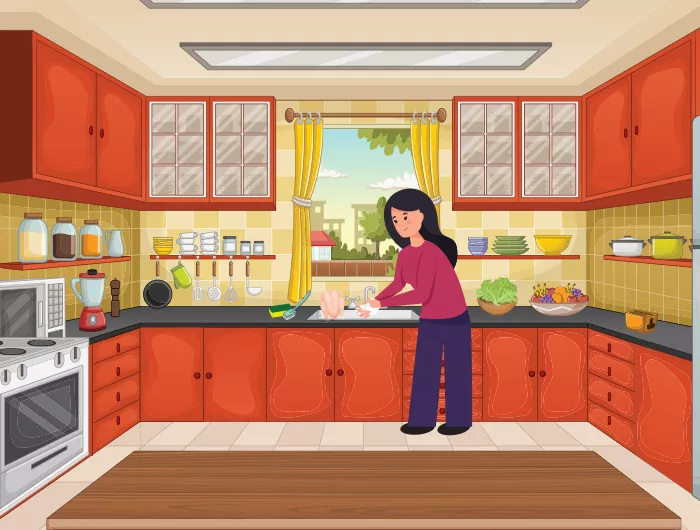How to keep your kitchen safe

denis_pc (kitchen), Helenshi (woman) - stock.adobe.com.
This content is free. Because CSPI takes no corporate or government donations, we rely on supporters like you to fuel our content. Donate now. |
Your kitchen harbors more bacteria than any other room in your house. While the lion’s share are harmless, some can cause nasty (and even long-lasting) effects. Here’s how to keep your kitchen safe.
Don’t mistake a tidy kitchen for a germ-free kitchen
Studies of people’s homes (even spotless-looking ones) turn up bacteria like Listeria, Staphylococcus aureus, Campylobacter, and E. coli on sinks, faucet handles, countertops, refrigerators, and more.
Germs from a contaminated sink could end up on foods that you put in it.
When researchers swabbed 100 home kitchens, they found Staphylococcus aureus in roughly 14 percent of samples, mostly from kitchen counters and refrigerator door handles.
What to do
To remove dirt and grease, clean all surfaces with warm water and dish soap (or a store-bought cleaner). Then disinfect with diluted bleach (1 teaspoon per cup of water) made in the past 24 hours. Or use a store-bought EPA-registered disinfectant (the back or side panel will say “EPA Reg. No.,” often in small print). Most disinfectants need a few minutes to do their job, so check the instructions on the label.
Disinfect your faucet handle daily and your sink weekly. Clean the refrigerator door handle and other high “touch points” like cabinet handles weekly.
Wash your hands well

In one study, all 30 participants said that washing their hands after handling raw meat was “very important.” (It is.) But when researchers watched them cook a hamburger, only 70 percent washed their hands after touching the raw meat.
In a study of 100 adults, 62 didn’t rub their palms together or wash between their fingers, and 47 didn’t use soap to wash their hands.
What to do
Wash your hands with soap and warm water for at least 20 seconds, making sure to clean between each finger. Wash before you start cooking, after each time you touch raw meat, poultry, seafood, or eggs, and after you finish cooking.
Clean your cleaning tools

Sponges, dish brushes, and dishcloths are often the most highly contaminated items in the kitchen.
In one study, Campylobacter survived for one day in all three types of sponges tested, while Salmonella survived for seven days in two of the three. Both bacteria are common in raw poultry.
What to do
Use cleaning tools for a single purpose. For example, dedicate a brush or sponge for dishes, a cloth for cleaning countertops, and a dish towel for drying clean hands.
Sanitize your dish brush, sponge, and dishcloths daily. Soak your brushes for a few minutes in diluted bleach (one teaspoon per cup of water) and let them air dry. Microwave your wet sponge (as long as it has no metal) for two minutes. Wash your dishcloths with bleach in the washing machine.
Follow the rinse rules

In a survey of roughly 1,500 people, nearly 70 percent said that they rinse raw poultry. Not a good idea. Rinsing can spread harmful germs to your sink and countertop rather than wash them off your poultry.
Washing bags of “ready to eat” (or even “triple washed”) greens is more likely to spread kitchen germs onto your greens than to wash away germs that may be on them.
Soaking leafy greens—bagged or not—can transfer germs from one leaf to another.
What to do
Rinse raw fruits and vegetables under running water. That will remove dirt and debris, and it may remove some harmful germs. (No washing method can remove all germs.) Skip the produce washes, which work no better than running water.
Watch out for cross-contamination

Researchers added a bacteria to chicken thighs before observing 300 volunteers prepare baked chicken and salad. Roughly 25 percent of the salads prepared by those who rinsed their chicken ended up with the bacteria. No big surprise there. But so did 20 percent of the salads made by those who didn’t rinse.
Turns out those who didn’t rinse the chicken also contaminated their sinks, likely by rinsing their hands after handling the raw poultry. And some volunteers placed salad ingredients—or prepared the salad—in the sink. Inadequate handwashing after handling the raw chicken may also have contaminated the salad.
What to do
After handling raw meat, poultry, seafood, or eggs, wash your hands, then disinfect the sink.
Keep raw meat, poultry, seafood, and eggs separate from foods that don’t require cooking. For example, don’t use a cutting board or knife to prepare vegetables after you’ve used it to prep raw meat.
Store smart

In one study of 100 homes, refrigerator temperatures ranged from freezing cold (26° F) to very warm (54° F).
In 97 of those 100 homes, raw meat, poultry, or seafood was stored on a shelf where it could leak onto ready-to-eat foods below.
What to do
Set your refrigerator to 40° F. (If your fridge doesn’t have a thermometer, buy one.) And don’t pack it too tightly. Air needs to circulate to chill the food.
Keep raw meat, poultry, and seafood wrapped securely or in a sealed container. Better yet, keep them in their own drawer or on a bottom shelf in case they leak.
Support CSPI today
As a nonprofit organization that takes no donations from industry or government, CSPI relies on the support of donors to continue our work in securing a safe, nutritious, and transparent food system. Every donation—no matter how small—helps CSPI continue improving food access, removing harmful additives, strengthening food safety, conducting and reviewing research, and reforming food labeling.
Please support CSPI today, and consider contributing monthly. Thank you.

STAY IN TOUCH
Our best (free) healthy tips
Our free Healthy Tips newsletter offers a peek at what Nutrition Action subscribers get—healthy recipes, scrupulously researched advice about food of all kinds, staying healthy with diet and exercise, and more.

